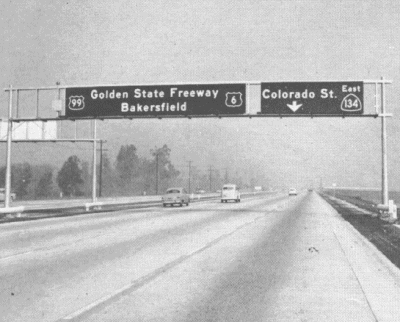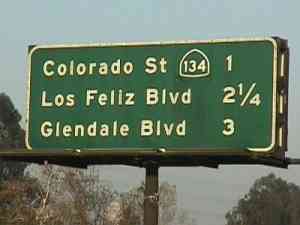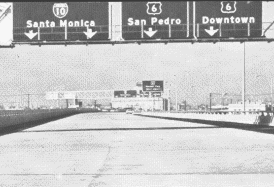by
B.J. on
9/08/2003 04:32:00 AM
0 comments
Print this post
Highway System in Los Angeles
(Heavy thanks to
this site. And
this site. And
this site.)
The story of highways in general is interesting because it brings to consciousness standardization within cultures and other crap like that.
It can take you from LA to Frisco (101), from Cal Poly Pomona to San Luis Obispo (OK, I'm not really sure how to do that). There's a sort of mystery to every little town like Soledad or Gonzalez I pass every time I make the trip up the 101, the El Camino Real, which used to link the 21 California missions to get to school. I've been intrigued by those mysteries and the histories of every town's inhabitants.
But Los Angeles is interesting in its own way. It brought the first freeway in the 6, the Arroyo Seco Freeway, which has since become the 110 according to this
timeline. It also established its own standards in the way highway signs were made as dotted out in this picture, from the fonts to the system used to tell the distance from an exit.

Notice that the signs are in white and black, rather than the standard green and white starting in 1964 today. This photo was taken in 1966 at Sunset Boulevard on the 405.
Kriske.com provides more thorough explanation:
"Early guide signs were crude and usually specific to the particular location. However, in 1956, state highway engineers developed a number of specific guidelines for creating signs to be standardized across the state.
The overhead sign that is now typical of all interstates was first used in California along heavily travelled urban freeway segments, and as of 1956 the Golden State was using overhead signing more extensively than any other state. Another California innovation was the use of white lettering on a black background, which enhanced visibility and legibility. Vestiges of these antique signs can still be found, most notably the black sign along Northbound Interstate 5 at the I-210/CA 14 truck route separation. Due to its success in California, this light-on-dark scheme was later incorporated for use in Interstate guide signs (using Green instead of Black) into the Manual on Uniform Traffic Control Devices (MUTCD), which specifies signage requirements for the Interstate (and Federal ?) System."

This photo was taken in 1974. Two things are radically different from those days as the Pasadena 11 has become the Pasadena 110, and the "Bakersfield" destination has been replaced with Sacramento.

The 7 freeway since 1985 has become the 710.

The 99, 6, and 134 freeways in 1959.

Now it's just the 5 and the 134.

Now the 10, 110 South to San Pedro, and 110 North to Pasadena. Notice how the US Routes were not the solid white that it is today, as seen on freeways like the 101.
Last but not least, there's
a nice historical picture of the 101 and 5 that is too big to fit on this blog.
And for more info on freeways, there's
this site. You can learn the full details on
Interstates,
how they numbered the highways, and pretty much anything about highways.
Labels: City Planning, Histories







